| In the course of time Konak along with its temples and sacred spots have lost their glories. It can neither be definitely said as to how long this temple stood in the fullness of its glory and splendour nor the causes of its decay. There are however, many speculations on this. The exact date and reason for the fall of this magnificent monument is still in mystery. History is almost silent about it. Scholars also differ in their opinions. In support of their views they putforth varied views. The various speculations made as to the possible cause of the fall of this magnificent temple are given below. | |||
| Incomplete Temple | |||
| It is opined by some historian that due to early death of the king Langula Narasimha Dev, the builder of the Konark temple, the construction of the temple had been left half-hazardly. As a result of this the incomplete structure collapsed in course of time. But this view stands without any basic data. It is rather established from the records of Madala Panji of Puri Jagannath temple as well as from some copper plates that the 1278 A.D. and the king Langula Narasimha Dev reigned till 1282. Many historian are of the opinion that the construction of the Konark temple was completed between 1253 and 1260 A.D. So the argument that due to non completion of the construction the temple collapsed is not tenable. | |||
| Insanctity | |||
| It is stated by some that according to the legend of Dharmapad, due to committed suicide of Dharmapada on the temple just after placing its crowning stone, the temple lost its sanctity and considered as an unfortunate (Asuva) element and was thus rejected. But it is recorded in the Madala Panji and many historians are of opinion that Sun god had been established in the temple and was being worshipped regularly for years together. So this argument is also not acceptable, being unfounded on history. | |||
| Curse Of Sumanyu | |||
| The great poet of Orissa Sri Radhanath Ray in his Kavya 'Chandrabhaga' has narrated a story about the cause of the fall of temple. According to that Kavya, Sumanyu Risi (saint) cursed the Sun god for his ill-behavior towards his daughter Chandrabhaga, who committed suicide. Hence the temple of the Sun god fell down. But such an imaginary story cannot be taken as a historical occurrence. | |||
| Engineering Defects | |||
| An the opinion of some Engineers, as usual with the progress of construction of the temple walls, its outside and inside were being filled with sand. After completion of the temple when the sands were cleared both from inside and outside, due to imbalance of pressure of walls the temple fell down. But many scholars do not agree with this argument, when they find the existence of a throne of the Sun god inside the temple. They also do not accept that such a procedure was followed in constructing the Sun temple. Besides there are historical documents that the Sun god was being worshipped in the newly constructed temple for a considerable period. | |||
| Earth Quake | |||
| Some scholars are of the view that due to earthquake the temple fell down. It is also not impossible on the part of a strong earthquake to demolish such a large structure at a moment.But there is no proof in support of occuring such an earth quake in this area. There is also no sign of suppression of the foundation of the temple at any direction. Had there been any such a strong earth quake causing the fall of the Sun temple, it could have also created a devastation in Konark area. And such an occurrence could have been remembered by the people as they have remembered the story of Dharmapada, Ramachandi and Bisu Maharana. Nowhere there exists such a devastating statement. | |||
| Thunderstruck | |||
| The arguments that the temple was affected due to Thunderstruck is also not acceptable. Since the temple walls are of 20 to 25 feet in thickness it is not at all possible on the part of any thunderstruck to disturb it in any manner. | |||
| Weak Foundation | |||
| It is also stated that due to weak foundation of such a heavy structure the temple fell down. But as stated earlier the temple was founded on a deep gorge of a river to make it stronger. And also there is no sign of sinking in any part. So this argument is also not founded on good grounds. | |||
| Load Stone | |||
| It is described that in the part there was a load stone on the top of the Sun temple and due to its magnetic effects it was drawing vessels passing through the Konark sea resulting in heavy damage. In others view due to the magnetic effects of the load stone placed on the top of the Sun temple the compass fitted in the ships to show the direction, was being disturbed and was not functioning properly and it was a troubling task in the part of the captains to drive their vessels in right direction. So to make the shipping save, the Muslim voyagers took away the load stone from the Sun temple. This load stone on the temple was working as the central stone keeping all the stones of the temple wall in a balance. Due to its displacement the temple walls lost their balance and fell down in course of time. But such a statement has no record in history nor has got any proof about the existence of such a powerful load stone on the temple top. | |||
|
|||
| Recently some scholars have advanced the opinion that there was a big image of a Lion which is called Flying lion on the upper part of the Sun temple just above the porch. Now the said image is found lying in the broken condition on the ground in three places. Due to placement of such a heavy block of stone on the temple walls, it imbalance the wall and the wall collapsed. But such an argument is yet to be reviewed carefully before we come to any conclusion. | |||
| Hasty Completion Of The Temple | |||
| It is learnt from the Dharmapad story that the king Narasimha Dev had ordered the sculptors to complete the temple about a fortnight earlier than the scheduled time and also had threatened them if they fail to complete the temple within the stipulated time, all the sculptors will be heavily punished to death. As the Sutradhar (Chief Architect) Sri Sibei Samantaray expressed his inability, the king engaged another person to speed up the work in place of Sri Samantaray. Though the newly appointed Sutradhar completed the work by the stipulated time, he, however, failed in placing the Kalas (the crowning stone ) of the temple. As the story goes, finally the Kalasa was set up by a boy of 12 years. It is evident, as a result of this impracticable order of the king many things had gone wrong. This resulted in weakening the placement of the crowning stone, which could not be placed properly according to the basic plan of the temple. Due to unusual hastying wish of the king and that to changing the Sutradhar at the last moment, the crowning portion of the temple could not keep pace with its lower parts. As a result the temple walls collapsed being imbalanced within a very short period. | |||
| Kalapahad | |||
| The most popular cause rests with the Kalapahad as the root of the
fall of Konark temple. According to the history of Orissa, Kalapahad invaded Orissa in
1508. Including Konark temple he had also destroyed a number of Hindu temples in Orissa.
It is described in the Madala Panji of Puri Jagannath temple that Kalapahad attacked
Orissa in 1568 and it was an evil hour for Orissa. Including Konark temple he broke most
of the images in most of the Hindu temples in Orissa. Though it was impossible to break
the Sun temple of Konark, the stone walls of which are of 20 to 25 feet thick he somehow
managed to displace the Dadhinauti (Arch stone) and thus made a way for the temple to
collapse. He also broke most of the images and other side temples of Konark. Due to
displacement of the Dadhinauti, the temple gradually collapsed and the roof of the
Mukasala also got damage due to the stroke of the stones falling down from the temple top.
Consequent upon, Orissa came under the Muslim administration in 1568 and there were constant attempts to destroy the Hindu temples. The Pandas of Puri, to save the sanctity of the Puri temple, took away the Lord Jagannath from the Srimandir and kept the image in a secret place. Similarly, it is said that the Pandas of Konark took away the presiding deity of the Sun temple out of the temple and put under sand for some years. Latter on the said image was removed to Puri and kept in the temple of Indra in the compound of the Puri Jagannath temple. According to others, the Puja image of the Konark temple is yet to be discovered. But others hold the view that the Sun image now kept in the National Museum, Delhi was the presiding deity of the Konark Sun temple. However, the Sun worship in the Konark temple was stopped consequent upon the removal of the image from the temple. This resulted in stopping of pilgrims to Konark. So also the port at Konark was closed due to attacks of pirates. Konark was as glorious a city for Sun worship as for commercial activities. But after the cessation of these activities, Konark turned to a deserted place and in ravages of time it became a field of pirates and wild animals. As a result Konark left to develop as a dense forest for years together. In 1626 the then king of Khurda, Raja Narasimha Dev, son of Purusottam Dev took away the Sun image to Puri along with two other moving deities - Sun and Moon. Now they are found in a temple in the compound of Puri Jagannath temple. It is recorded in the Madala Panji of Puri temple that in 1028 Raja Narasimha Dev had ordered for taking measurement of all the temples at Konark and made an account of the temples at Konark goddesses. At the time of measurement the Sun temple was in existence upto its Amalak sila, i.e. about 200 feet in height. Kalapahad had only destroyed its Kalas, the crowning stone and the Padma-dhwaja, the lotus finial and the upper portions. Due to removal of this crowning stone the temple lost its balance and gradually started to fall down. The stroke of heavy stone pieces caused considerable damage to the porch. As described earlier there was a big block of stone called Navagraha Paata placed in front of the Mukhasala. The then king of Khurda removed the said block to down. The king had taken away many sculptured stones from Konark and constructed some portions of Puri temple with them. Even he had breaking its roof. During Marahatta time the outer compound wall of the Puri temple was constructed with the stone of Konark temple. It is reported that among all the temples the Naata Mandir or the Dancing hall of Konark was in its origin form for a longer period and it was broken intentionally considering it as an unnecessary structure during the time of Marahata administration. In the year 1779 a Marhatta Sadhu had taken away the Arun Pillar from Konark and put it in front of the Lion's Gate of Puri Jagannath temple. Thus by the end of 18th century Konark lost all its glories and had been turned to a dense forest. In course of time, the temple area thus became devoid of people being covered with dense forest and full with sands and filled with terrible animals and abided by pirates. It is said that even the local people feared to go to Konark in the broad day light. |
|||
Thursday, August 29, 2013
Fall of konark temple
RAJARANI TEMPLE
Raja Rani Temple – Bhubaneswar’s Love Temple
Kalinga – A mighty kingdom of yore
Odisha’s history runs back by thousands of years. Kalinga Desa, as the region of Odisha was known has been one of the strongest kingdoms since the times of Mahabharata. It has gone down in history and became a legend associated with the great Kalinga War of Asoka, a war which changed the conquest thirsty ways of Asoka and in turn the history of India !
Odisha saw the raise of several great dynasties and kings like Kharavela in the 1st Century BC, the Eastern Ganga Dynasty of the 11th Century AD, the Gajapathis of the 14th Century AD. These dynasties have left behind gems of architectural monuments, one of them has gone on to attain UNESCO World Heritage Site status.
Not many of us really know much about the history of Odisha, neither do our textbooks teach us much. We too didn’t have much of an idea until we actually visited the place that was once a seat of great glory.
Raja Rani temple
Our Odisha tour began with the temples of Bhubaneshwar and the first temple on our list was the Raja Rani Temple.
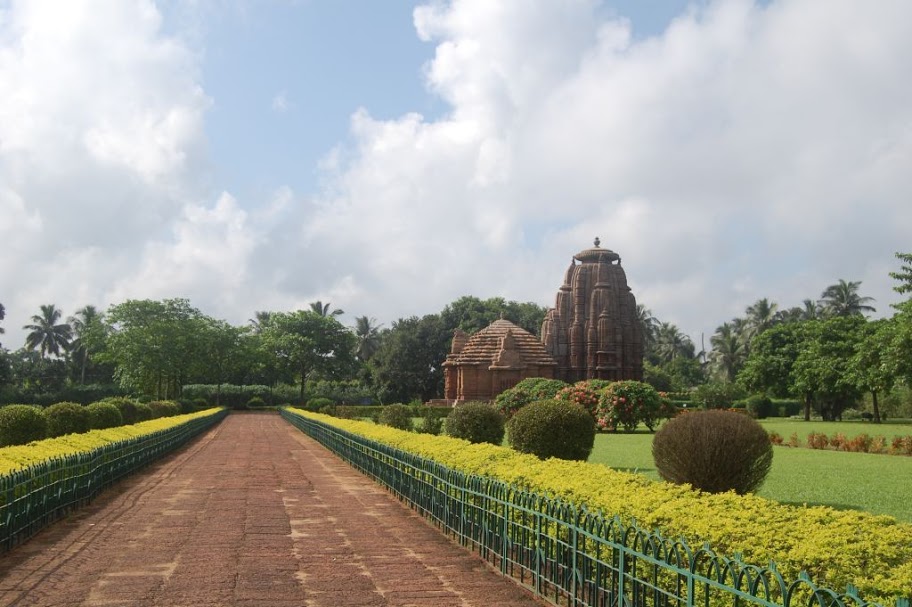
Built in the 11th Century A.D during the reign of the Eastern Ganga Dynasty, the Raja Rani temple is believed to have been originally called Indreswara. Wikipedia tells us the locals call the temple “Love Temple” because of the erotic sculpture.
The first thing that strikes you when you enter the temple is how well it is maintained with lawns and gardens. The temple itself stands amidst the greenery, elegant and graceful.
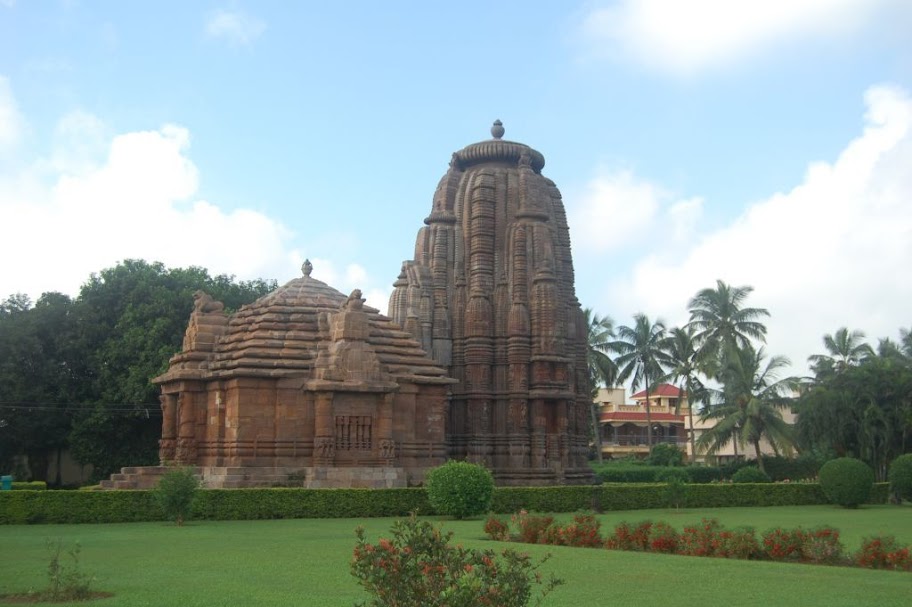
Named for a stone !
When we heard the name “RajaRani”, we thought it was a private temple of the king and queen. It turns out that the temple was named so because of a variety of sandstone used to build it, locally called “Raja Rania” !
The Vimana or the main tower is 55 feet high and has some of the most intrinsic and complicated sculpture you will find in temples in India.
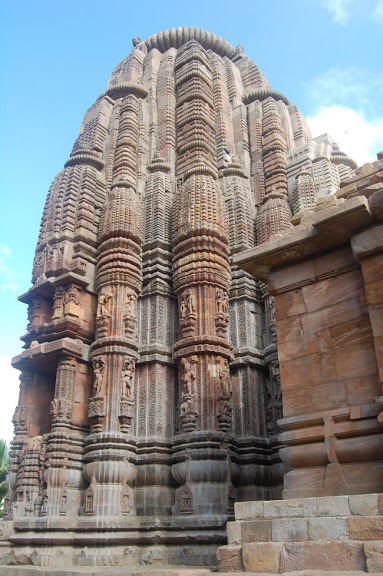
The entire Vimana and the temple is covered in minute sculptural designs. Imagine sculpting designs like these manually with no machines or tools except maybe a chisel and a hammer !
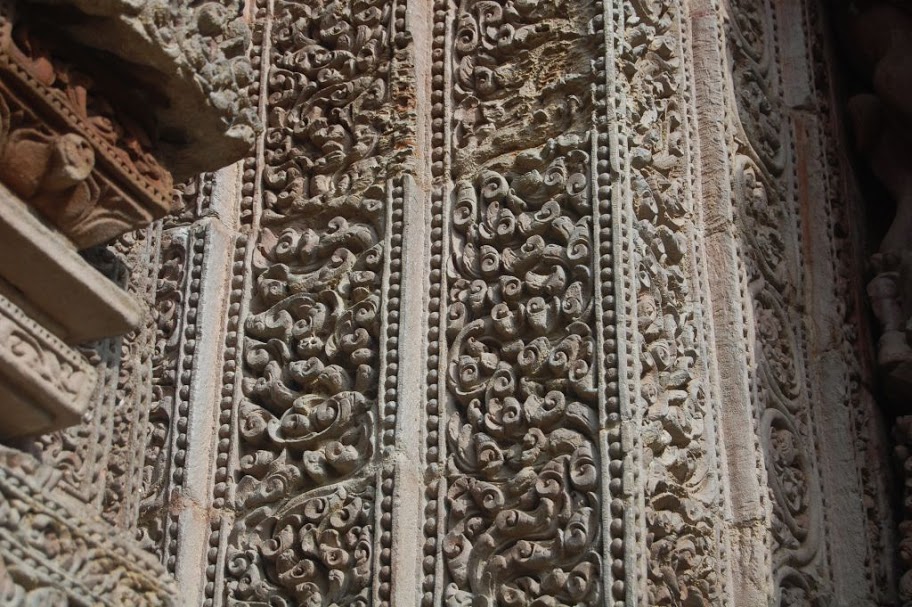
You can only bow down to the patience of those ancient sculptors !
Another favourite subject of the temples in Orissa or for that matter most temples in India is women ! The Vimana and the Jaganmohana, the front porch are full of women, some going about their daily life, some at their seductive best, some fighting wars but all of them depicting woman power. Here is a woman talking to her pet parrot !

You wonder how the sculptors managed to achieve perfection even while sculpting such minute images !
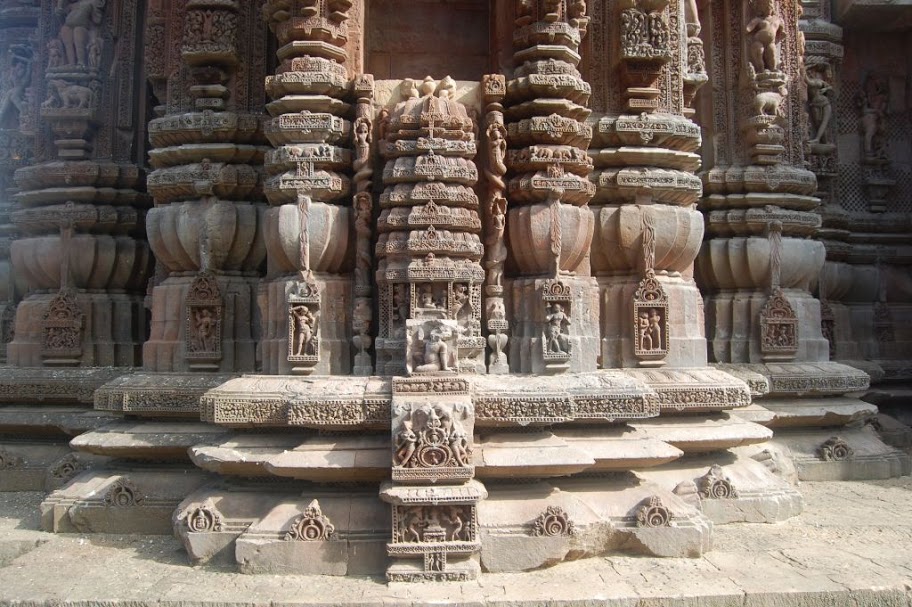
Mystery of the Deity
At the entrance of the temple are two pillars with Naga guards wrapped around them.

Check out how a portion of the tail has been sculpted to look like they are wrapping around the pillar, what an eye for detail !
While the outer part of the temple is rich and ornate in sculpture, very interestingly, the sanctum sanctorum is devoid of any images, there are no images of any God or any sculpture.

There is no clear record of who the presiding Deity was, though the popular belief based on the sculpture and other images indicate that it was a Shiva temple.
Odisha’s history runs back by thousands of years. Kalinga Desa, as the region of Odisha was known has been one of the strongest kingdoms since the times of Mahabharata. It has gone down in history and became a legend associated with the great Kalinga War of Asoka, a war which changed the conquest thirsty ways of Asoka and in turn the history of India !
Odisha saw the raise of several great dynasties and kings like Kharavela in the 1st Century BC, the Eastern Ganga Dynasty of the 11th Century AD, the Gajapathis of the 14th Century AD. These dynasties have left behind gems of architectural monuments, one of them has gone on to attain UNESCO World Heritage Site status.
Not many of us really know much about the history of Odisha, neither do our textbooks teach us much. We too didn’t have much of an idea until we actually visited the place that was once a seat of great glory.
Raja Rani temple
Our Odisha tour began with the temples of Bhubaneshwar and the first temple on our list was the Raja Rani Temple.

Built in the 11th Century A.D during the reign of the Eastern Ganga Dynasty, the Raja Rani temple is believed to have been originally called Indreswara. Wikipedia tells us the locals call the temple “Love Temple” because of the erotic sculpture.
The first thing that strikes you when you enter the temple is how well it is maintained with lawns and gardens. The temple itself stands amidst the greenery, elegant and graceful.

Named for a stone !
When we heard the name “RajaRani”, we thought it was a private temple of the king and queen. It turns out that the temple was named so because of a variety of sandstone used to build it, locally called “Raja Rania” !
The Vimana or the main tower is 55 feet high and has some of the most intrinsic and complicated sculpture you will find in temples in India.

The entire Vimana and the temple is covered in minute sculptural designs. Imagine sculpting designs like these manually with no machines or tools except maybe a chisel and a hammer !

You can only bow down to the patience of those ancient sculptors !
Another favourite subject of the temples in Orissa or for that matter most temples in India is women ! The Vimana and the Jaganmohana, the front porch are full of women, some going about their daily life, some at their seductive best, some fighting wars but all of them depicting woman power. Here is a woman talking to her pet parrot !

You wonder how the sculptors managed to achieve perfection even while sculpting such minute images !

Mystery of the Deity
At the entrance of the temple are two pillars with Naga guards wrapped around them.

Check out how a portion of the tail has been sculpted to look like they are wrapping around the pillar, what an eye for detail !
While the outer part of the temple is rich and ornate in sculpture, very interestingly, the sanctum sanctorum is devoid of any images, there are no images of any God or any sculpture.

There is no clear record of who the presiding Deity was, though the popular belief based on the sculpture and other images indicate that it was a Shiva temple.
Simhachalam
History Varaha Narasimha Temple
Sri Varahalakshmi Narasimha Swamy as the presiding deity.
The deity at Simhachalam, the lion-man incarnation of Lord Mahavishnu is usually covered with sandalwood paste. The original shape of the deity in the tribhanga posture has two hands with the head of a lion on a human torso. An inscription dated as far back as 1098 AD of the Chola king Kuloththunga provides some clue as to its antiquity. Another inscription shows a Queen of the Eastern Ganga of Kalinga(ancient Orissa) (1137-56 AD) covering the image with gold while a third inscription says the eastern Ganga King of Orissa Narasimha Deva built the main/central shrine in 1267 A.D. With more than 252 inscriptions in Oriya and Telugu describing the antecedents of the temple, it is a historically important monument.
Sri Krishna Deva Raya after defeating the Gajapati ruler of Orissa Gajapati Prataparudra Dev visited the shrine twice in 1516 AD and 1519 AD and offered numerous villages for maintenance of bhogam (worship) along with valuable jewellery of which an emerald necklace is still in the temple. For the last three centuries the Royal family of Vizianagaram, " The Pusapati Gajapathi's" have been the temple's trustees.

The Eastern Gangas : A Kings List
Eastern Gangas were probably an offshoot of the Western Gangas that ruled the Mysore regions of Karnataka.
The Eastern Gangas had their capital at Kalinganagara (Mukhalingam in the Ganjam district/ modern Srimukhalingam in Srikakulam District of Andhra Pradesh) and secondary capital at Dantapura (Palur).Their kingdom comprised of regions in Orissa,W.Bengal , Chattisgad,Jharkand and Andhra Pradesh. The family satarted around 550 AD and ruled for around 400 years.
They constructed the famous temples of Jagannatha and Konark (a world heritage site) which are a testimony to their architecture and grandeur.
Early Eastern Ganga kings
Indravarman founder of the dynasty.Ruled in the year 39 of the Ganga era.
Devendravarman IV last known ruler of this dynasty. Issued a grant in the year 39 of the Ganga era (c.893AD)
In the next century Kalinga was conquered by the Eastern Chalukyas and later the Chola kings Rajaraja the Great and Rajendra.
Later Eastern Ganga Kings
Vajrahasta Anantavarman 1038 AD. first ruler of this dynasty.
Rajaraja (son)
Anantavarman Chodaganga (son).1078-1147. formally ascended the throne in 1078 (before he assisted in father in the rule of the kingdom). He gave shelter to the Eastern Chalukya king Vijayaditya which proved the wrath of his rival ,the Chola king Kulotunga, who twice attacked Kalinga. But Anantavarman recovered his kingdom and also wrested Vizagapatnam from the Cholas (but it was recovered later by Kulotunga Chola). Annatavarman later invaded the Bengal regions of the Palas and pushed is conquests upto Hooghli district (After Anantavarman, the Bengal regions were conqured by the Sena kings). Gangas under Anantavarman also conquered ther parts of Orissa and and called themselves Lord of Utkala and Lords of Trikalinga. Anantavarman ruled at least upto 1147 AD.
Anantavarman constructed the famous temple of Jagannatha at Puri.
Anangabhima II (son)1178-1198
Rajaraja II (grandson)1198-1211. resisted attacks(1205 AD) by Mohameddans under Muhammed Bakhtyar who invaded Orissa after occupying Bengal from the Senas.
Anangabhima III (son) 1211-1238. He also resisted attacks from the Mohammedans under Khilji Ghiyasuddin Iwaz, the ruler of Bengal. He successfully fought the Kalachuris of Tumanna but was defeated by Kakatiya Ganapati.
Narsimha I (son) 1238-1264. He invaded muslim dominions of Bengal in 1243 AD and advanced upto Gauda but when the Muslim king of Awadh came to te help of the Bengal king, their collective might defeated the force of Narasimha and occupied some Ganga territories as well.
Narsimha built the famous temple of Konark at Puri.
Bhanudeva (son) 1264-79
Narsimha II (son)1279-1306. recovered Ganga territories from the Mohammedans. And advanced as far as the Ganga banks (from where he issued some land grants in 1296AD).
Bhanudeva II (son)1306-28. repulsed attack of Mohamedans under Ulugh Khan sometime in 1323.
Narsimha III (son) 1328-52
Bhanudeva III (son)1353-78 AD. suffered greatly under repeated invasions from Shamsuddin Ilyas Shah of Bengal, Bukka of Vijayanagara and lastly Firoz Tughluq of Delhi. Bhanudeva III submitted to Tughlaq, but redeclared his independence after his departure.
Narsimha IV (son)1379-1424. During his reign the Mulim rulers of Deccan,Jaunpur and Malwa led military expeditions in Orissa, but Narsimha IV stoicly resisted these attacks.
Bhanudeva IV (1424-1434) son, His throne was usurped by his minister Kapilendra, who started his own independent dynasty called Suryavamsa in AD.1434, marking the end of the Ganga dynasty.
source: http://indianhistory-ace.blogspot.in
PADMASHREE
DR. SATYANARAYANA RAJGURU :
Some
men are born great, while some achieve greatness during their lifetime. Dr. Satyanarayana Rajguru was a man of
multidimensional character. He was
a poet, a writer, a dramatist, a stage director, an actor, a freedom fighter, a
linguist, an orator, an historian and a research scholar.
He
started his education at the age of five.
From his childhood he was a man of independent mind. Though a meritorious student, he could
not be qualified in the matriculation examination, intentionally. However, he passed the Oriental
Title Examination in ‘Oriya & Sanskrit’ from the Andhra University. In the year 1929 he worked as the
manager of the ‘Parala Padmanabha Rangalaya’ and entered in to the field of
theater during 1935. He took active
part in the ‘Utkal Sameemani’ &
‘Odiya Rakshya’ and helped Sri Krushna Chandra Gajapati in the formation of
‘Utkal Pradesh’. He will be
remembered for his thesis presented
before the State Re-organisation Commission. He was the President of Ganjam District
Education Council from 1942-1945.
In the year 1946, he joined as an assistant in the Kalinga Historical
Research Society at Bhawanipatana. He worked as a Curator in the Orissa Museum
from 1950-1961 and an Epigraphist from 1963-1970. He also worked as a member in the
working committee of the ‘Orissa Sahitya Academy’. He was also the Chairman of the
Paralakhemundi Municipality for 16 years.
The
Andhra Mahasabha conferred him with the ‘Bharati Bhushan’ award. He was also
awarded by the Ganjam Sahitya Sammilani (1968), Orissa Sahitya Academy (1968),
“PADMASHREE” by the President of India Shri V.V.Giri (1974), D.Litt. by
the Berhampur University and a life member in the University Senate (1975),
Utkal Pathak Sansad (1977), Orissa Congress (1980), “SARALA SANMAN”
(1989) for his outstanding and meritorious research work.
Some of his works are:
-
‘PALINKI
BAHAKA’: A poem translated IN Oriya from ‘The Palanquin Bearers’ of Sarojini
Naidu
‘SWAPANE CHUMBAN’, ‘JANANI UTKAL’,
‘RADHAVISEK’, ‘ODIALIPIRA KRAMABIKASH’, ‘HISTORY OF GANGAS’, ‘THE KORASANDA
COPPER PLATE GRANT OF VISAKHAVARMMA’,
‘HISTORY OF EASTERN GANGAS OF KALINGA’,
‘HEIROGRAPHIC LETTERS OF NARAJ’, ‘THE ODRAS AND THEIR PREDOMENANCY’, ‘THE
HISTORICAL RESEARCH IN ORISSA’, ‘THE KONDULI COPPER PLATE GRANT OF NARASIMHA
DEVA OF SAKA 1305’, ‘SUMANDAL PLATES OF DHARMARAJ’.
Subscribe to:
Posts (Atom)
